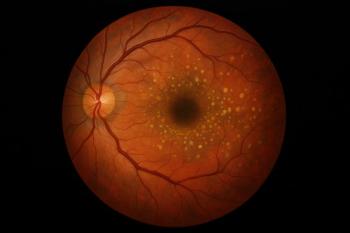
Low-Dose Atropine Drops: Safe Treatment for Floaters | ASRS 2025
Small doses of the involuntary nervous system blocker, atropine, may offer a non-invasive treatment for symptomatic vitreous floaters, according to a recent small study.
The off-label use of 0.01% atropine drops is a safe and noninvasive way to treat symptomatic vitreous floaters, according to a study done by Mohsin H. Ali, M.D., who presented his findings today at the 43rd annual meeting of the American Academy of Retina Specialists.
Floaters are small spots or lines
In Ali’s study, 44 patients with an average age of 60 were instructed to take 0.01% atropine drops. Patients were given a National Eye Institute Visual Function Questionnaire (NEI-VFQ) before and after using the drops for one week.
Half (22) of the patients completed at least 7 days of consecutive use and returned questionnaires. Of those, 13 out of 22 (59%) were “satisfied” or “very satisfied” with the drops and said they would continue use and half said they would continue use.
Overall, 13 out of 44 (30%) were “satisfied” or “very satisfied” with the drops and said they would continue use and 11/44 (25%) just said they would continue use.
“The efficacy is low, but despite this, I think it is a good therapeutic option to have in your pocket, given that the other options carry the risk of vision-threatening complications,” Ali said during his presentation.
Different iris colors, phakic status or PVD status did not seem to meaningfully affect satisfaction rates.
Adverse events included worsened near vision (18%), worsened distance vision (18%) and light sensitivity (18%).
Ali personally prescribes this treatment for patients for long-term use or as needed, but not for patients with acute posterior vitreous detachment.
During the Q&A portion of the session, audience member Wei-Chi Wu, MD, PhD, professor and Chairman of Ophthalmology at Chang Gung University, asked Ali whether he considered using higher amounts of atropine to treat patients. Wu pointed out that patients may not be getting the full benefit of just a 0.01% dose.
“In my anecdotal experience, I've had other patients come back and say, ‘I refuse to use this drop any further because of the light sensitivity that it caused,’” Ali said. “In adults with various other pathologies and different colored irises, you might find that there is still pupillary dilation even at this low dose.”
Ali continued by saying that while they did not measure pupil size before and after drop administration, some individuals did send iPhone pictures that showed “significant pupil dilation.”
Ron Adelman, M.D., Chair of the Department of Ophthalmology at the Mayo Clinic in Florida, asked about the mechanism of action of low-dose atropine.
Ali replied that while he doesn’t fully understand the mechanism of action, it seems to have to do with pupillary dilation.
“A lot of you probably have anecdotal experience when patients come to you in the office with a chief complaint of floaters, and then when they are dilated, they look around the room and say, ‘I don't really notice my floaters.’ Part of that may be because you are talking to them when they have had a full pupillary dilation.”
Newsletter
Get the latest industry news, event updates, and more from Managed healthcare Executive.




















































